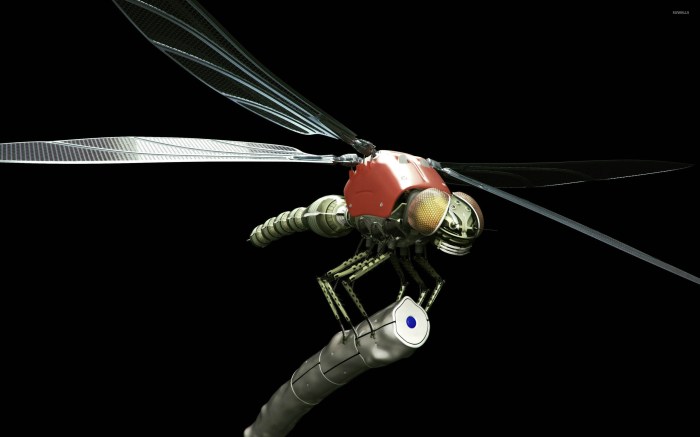Bionicopter robot dragonfly – the name itself conjures images of futuristic flight, a sleek, insect-like machine mimicking nature’s own aerial acrobat. This isn’t science fiction; it’s cutting-edge robotics, pushing the boundaries of biomimicry and redefining what’s possible in aerial technology. Imagine a tiny, agile drone, capable of navigating complex environments with the grace of a dragonfly. That’s the promise of the bionicopter, and it’s closer to reality than you might think.
This marvel of engineering combines sophisticated aerodynamics, advanced materials, and intricate control systems to achieve unprecedented levels of maneuverability and precision. From its design inspired by the dragonfly’s elegant wings to its potential applications in surveillance, search and rescue, and environmental monitoring, the bionicopter represents a significant leap forward in robotics and bio-inspired engineering. We’ll delve into the mechanics, control systems, and future possibilities of this incredible creation.
The Bionicopter, a marvel of bio-inspired engineering, doesn’t simply flap its wings and hope for the best. Precise control and navigation are crucial for its stable flight, demanding sophisticated algorithms and sensitive sensors. Let’s delve into the mechanics behind this impressive feat of robotic engineering.
The Bionicopter’s flight control system is a complex interplay of algorithms, sensors, and a cleverly designed power source. Achieving stable flight with a bio-inspired design presents unique challenges, as mimicking the agility and precision of a dragonfly requires a delicate balance of power, responsiveness, and stability. This intricate system allows the Bionicopter to perform complex maneuvers, mimicking the natural flight patterns of its biological counterpart.
Control Algorithms
The Bionicopter’s flight path is guided by a sophisticated set of control algorithms that translate pilot commands (or pre-programmed instructions) into precise adjustments to the wing movements. These algorithms incorporate feedback from various sensors to maintain stability and accuracy. They are designed to handle various flight conditions, from gentle hovering to rapid turns and dives. Think of it as a highly advanced autopilot system tailored for a tiny, incredibly agile flying robot. The algorithms are likely based on principles of feedback control, continuously adjusting wingbeat frequency, amplitude, and angle to achieve the desired trajectory.
Sensors and Feedback, Bionicopter robot dragonfly
A network of miniature sensors provides crucial feedback on the Bionicopter’s position and orientation. These include accelerometers to measure linear acceleration, gyroscopes to detect angular velocity, and potentially even GPS for outdoor navigation. These sensors constantly feed data to the control algorithms, allowing for real-time adjustments to maintain stability and follow the desired flight path. Imagine the sensors as the Bionicopter’s “senses,” providing critical information about its position and movement in three-dimensional space.
Challenges in Achieving Stable Flight
Achieving stable and controlled flight with a bio-inspired design like the Bionicopter presents significant challenges. The delicate wing mechanism, influenced by air currents and other environmental factors, requires extremely precise control. Maintaining stability in the face of unpredictable wind gusts or minor mechanical imperfections demands robust control algorithms and highly responsive sensors. Furthermore, the small size and lightweight construction of the Bionicopter necessitate efficient energy management to extend flight duration.
Power Source and Efficiency
The Bionicopter’s power source, likely a lightweight battery, directly impacts its flight duration. The efficiency of the power source and the energy consumption of the actuators (motors driving the wings) are critical factors in determining how long the Bionicopter can stay airborne. Minimizing energy consumption without sacrificing performance is a major engineering challenge. The battery life would need to be carefully balanced against the need for sufficient power to execute maneuvers and maintain stable flight. For instance, a longer flight might require a larger, heavier battery, potentially impacting the overall agility of the robot.
Flight Control Sequence
The following flowchart illustrates the sequence of actions involved in controlling the Bionicopter’s flight:
The process begins with the pilot inputting a desired flight path or maneuver. This instruction is then processed by the control algorithms, which calculate the necessary wing adjustments. The algorithms use sensor feedback (from accelerometers, gyroscopes, and potentially GPS) to monitor the Bionicopter’s actual position and orientation, comparing this to the desired path. Any discrepancies trigger further adjustments to the wing movements. This continuous feedback loop ensures stable and accurate flight, constantly adapting to changing conditions.
A simplified representation could be:
Pilot Input → Control Algorithms → Wing Adjustments → Sensor Feedback → Comparison → (Repeat if necessary)
The bionicopter robot dragonfly isn’t just a technological achievement; it’s a testament to the power of biomimicry. By studying nature’s designs, we’ve unlocked new possibilities in robotics, creating machines that are more efficient, agile, and adaptable than ever before. The future applications of this technology are vast, promising advancements in various fields and potentially revolutionizing how we interact with the world around us. As the technology continues to evolve, we can only imagine the even more impressive feats this tiny marvel will accomplish. The flight of the bionicopter is a flight into the future, and it’s a journey worth watching.
 Invest Tekno Berita Teknologi Terbaru
Invest Tekno Berita Teknologi Terbaru
